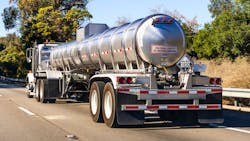For carriers, navigating regulatory compliance is like hacking through a jungle filled with twisting vines of code while being stalked by a leopard with citation claws. This is especially true for cargo tank fleets transporting volatile goods, where the rules for safe operation are even more obscure, but equally critical.
Fortunately, at Tank Truck Week 2023, which ran Oct. 8-11 in Indianapolis, several panels and educational sessions provided clarity and education for tank fleets. This included a session in which experts covered the finer details of venting upgrades, rear impact guards, the upcoming Canadian Harmony rule, and the potential Pipeline and Hazardous Materials Safety Administration (PHMSA) HM-265A regulation update.
John Freiler, engineering manager for the Truck Trailer Manufacturers Association (TTMA); Peter Weis, chief engineer for Engineered Transportation International; and Dave Adams, director of design engineering at Betts Industries; guided the presentation.
Venting upgrades
Adams talked about upgrading tank venting valves, a process made more complicated when each vent must meet specific requirements depending on the tank.
“Each tank is going to have different requirements for their venting, so that dictates what venting you're using,” Adams explained. This means fleets must check the tank nameplate to discern if they’re using a DOT 306, DOT 406, DOT 407, or DOT 412, and keep their tank’s maximum allowable working pressure (MAWP) in mind.
“That's basically saying what the tank is rated for and that controls the set pressures of your venting,” Adams said. “You can't put a high-set pressure vent on the tank; it can't handle the pressure.”
“Any PRV that's installed on a 306 or 406, regardless of what kind of spec it is, has to meet the surge protection,” Adams emphasized. “That goes back onto the manufacturer of that pressure relief device to certify that when [the trailer] is in an impact, [the PRV] has the ability to hold back an increase in pressure and keep that leak to less than 1 liter.”
On paper, it’s simple enough that an upgraded PRV must meet the cargo tank's original venting requirements. But this can be harder than it looks due to the set pressure ratings on certain valves.
“If you have an MC 306 tank and you use an MC 306 reclosing pressure relief valve, it must open at not less than 3.0 psi and not more than 4.4,” Adams explained. “If you upgrade to that newer [reclosing pressure relief valve], it now directs you back to the pressures that are set forth in the DOT 406 section 178.346-3. What that does is turn a set pressure into a function of the MAWP. You have to calculate what your set pressure is going to be and you have to make sure that the PRV fits within the window, rather than just knowing your original 306 met the requirements of either 3.0 or 4.4.”
For 406 vents, that set pressure function must meet 110-138% of the MAWP. This creates a discrepancy when mixing 306 tanks with 406 valves, making fleets vulnerable to citation when 406 PRVs have a manufacturer-set pressure that is calculated with MAWPs from DOT 406 cargo tanks. To an inspector, this makes it look like the set pressure on the 406 PRV is higher than the set pressure window of 3.3-4.14 psi required on DOT 306 tanks, even if the valve in question still matches airflow capacity and surge protection requirements.
“To avoid confusion and potential regulatory misinterpretation, it's highly recommended that any PRV install on an MC 306 cargo tank should be a PRV specifically designed for MC 306 units with surge protection,” Adams advised.
Rear impact guards and the Canadian Harmony rule
EnTrans' Weis explained the changes to rear impact guard (RIG) regulations due to the Canadian Harmony rule. Prior to 2023, the Canadian and American RIG regulations were similar, but not quite identical due to differing load requirements in Canada, where RIGs are required to be roughly 3.5 times stronger than their U.S. equivalents.
But in 2015, lawmakers proposed that U.S. regulations mimic their northern partners', and now the new U.S. rules will be identical to Canada’s beginning on July 15, 2024. But the upcoming deadline might not be as intimidating as it seems.
“You may or may not notice changes to the written [tanker] design,” Weis said. “That’s because many U.S.-built RIGs are Canada compliant already, especially with van trailers. They didn't want to build two different designs, so they voted to comply with the Canada requirements and they ended up complying with both.
“If you do see a new design, it’ll be heavier and more costly than the old U.S. design,” Weis concluded.
Another reason fleets might not see any shifts in their trailer designs is if their tanks are already exempt to the RIG regulation due to their wheels. To comply with weight regulations, many tankers have their back tires set closer to the rear of the trailer, and if there is a maximum of 12” between the back tires and the rear of the vehicle, then no RIG is needed.
“That's because in an accident, the tires prevent underriding, maybe better than the guard itself, from the trailer,” Weis explained.
However, with the upcoming unification, does that mean other stronger standards could be on the way? After all, the National Highway Traffic Safety Administration asked for comments on a proposed regulation for side underride guards (SUGs) this summer. It’s not unreasonable to wonder if stronger RIGs could lead to more SUGs.
Ultiamately, Weis does not anticipate this “any time soon,” he said. “The fact is that a full-length guard on both sides of the trailer is quite heavy and takes away payload, which means you're going to have more trucks on the road. And a lot of times that opens up the idea that you're going to negate your saving of lives by having more trucks on the road, more miles driven.”
Freiler also said TTMA is among those who don’t fully agree with NHTSA’s assessment on the impact of SUGs, and that more research needs to be done before regulations are put in place.
TTMA responds to proposed PHMSA regulations
Finally, Freiler discussed PHMSA’s proposed HM-265A updates, which include several changes for hazardous material transport at large but could impact tanker carriers specifically.
In particular, Freiler outlined how TTMA took issue with four specific topics of the proposed rule, but stressed that there could be others as well:
- I. Standards Incorporated by Reference
- FF. Mounting Pads for Cargo Tank Damage Protection Devices
- Registered Inspector Issues (LL, NN, & PP)
- Design Certifying Engineer Issues (MM, OO, & QQ)
Of these topics, the mounting pad discussion and registered inspector issues have the most immediate relevance for tanker fleets. The former section outlines how appurtenances, or items welded to the shell of the tank, are required to have a separate pad beneath them with a certain set back and thickness. While TTMA approves the safety benefits of the rule, Freiler explained how they disagree with PHMSA’s current definition of appurtenance, which includes overturn rails. This would place many tankers out of compliance, even though overturn rails are already regulated by 49 CFR 178.345-8(a)(3).
“The requirements for accident damage protection are already in excess of the requirements for appurtenances,” Freiler said. “We don't believe that PHMSA intended to make all 100,000 existing gasoline tankers out of compliance with the regulations. We really think the problem lies with mis-categorizing accident damage protection as an appurtenance.”
Secondly, HM-265A’s LL, NN, and PP sections outline potential certification changes for cargo tank inspectors. Currently, inspectors must have either an engineering degree and one year of experience, an associate degree in engineering and two years of experience, a high school diploma and three years of experience, or three years of experience prior to 1991. However, the Federal Motor Carrier Safety Administration (FMCSA) has found cases where registered inspectors were performing poorly or where tank trailers were not examined by registered inspectors at all, as was the case when almost 200 MC-330 and MC-331 trailers at the Meeder Equipment Company/Ransome Manufacturing facility in Fresno, California, had to be reinspected.
To address the issue of inspector qualification and standards, Freiler explained that TTMA believes a more streamlined path to certification is necessary, as well as oversight on inspectors once they’re working. “An inspection shop needs to have one or two people already set up as inspectors in training so that they can get those years of experience,” Freiler noted. “But these days, people quit their jobs, they move along, and shops could suddenly find themselves without somebody on hand. There's no way for them to get an inspector in quickly.”
This is partially what leads to underqualified inspectors at tanker manufacturing facilities. But in Freiler’s view, more intensive inspector restrictions and certification isn’t the solution.
“What they need is a way to have an accelerated education path, to have somebody go and take a fast course that focuses on the needs of an inspector in particular, so that they can train up and be ready to go in a short period of time,” Freiler said. Additionally, the industry would need a way to review and rate inspections so under-performing inspectors can receive feedback and extra training.
Of course, if this program is developed, it could lead to many reinspections as the industry redefines and reinforces inspector qualifications.
“If they have a way of tracking a particular inspector and find this inspector is not doing their job, then they might go and pull those [trailers for reinspection],” Freiler acknowledged.
About the Author

Alex Keenan
Alex Keenan is an associate editor for Fleet Maintenance magazine. She has written on a variety of topics for the past several years and recently joined the transportation industry, reviewing content covering technician challenges and breaking industry news. She holds a bachelor's degree in English from Colorado State University in Fort Collins, Colorado.

